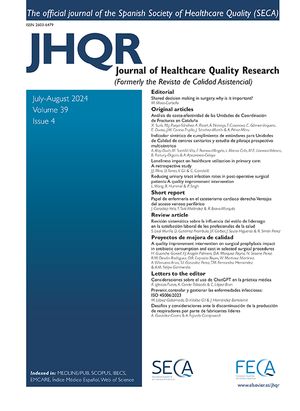En el cáncer de mama, la cirugía oncoplástica pretende conseguir el control local del cáncer (objetivo oncológico) con la menor alteración de la estética de la mama y sin la pérdida de la imagen corporal (objetivo estético).
ObjetivoValorar la oportunidad de la aplicación de las técnicas de cirugía oncoplástica en el cáncer de mama, reconstrucción y/o remodelación después de cirugía conservadora en nuestro centro.
Material y métodoEl trabajo se ha realizado en dos fases: a) revisión retrospectiva de los datos incluidos en la historia clínica de pacientes mastectomizadas, con el objetivo de valorar las posibilidades de aumentar las indicaciones de cirugía conservadora, y b) valoración de los resultados cosméticos de las pacientes con cirugía conservadora. Los números de las historias clínicas de las pacientes intervenidas por cáncer de mama correspondientes al año de estudio (2000) han sido suministrados por el Servicio de Admisión y Documentación Clínica. Se han revisado 27 historias clínicas, y se han considerado contraindicaciones absolutas para la indicación de cirugía conservadora: mayor de 70 años, multicentricidad, cáncer inflamatorio, linfangitis carcinomatosa, carcinoma intraductal extenso y deseo de la paciente. Se han evaluado los resultados estéticos de 16 pacientes con cirugía conservadora por tres evaluadores independientes: cirujano, enfermera y médico que fue anteriormente paciente mastectomizada.
ResultadosEn 10 (37%) de las historias revisadas no se constatan criterios absolutos que contraindiquen la posibilidad de realizar cirugía conservadora con remodelación (cirugía oncoplástica). Los resultados cosméticos de la cirugía conservadora son mediocres. En casi la mitad de las pacientes los resultados son inaceptables, malos o muy malos.
ConclusionesEn nuestro hospital existe una oportunidad de mejora en el tratamiento quirúrgico del cáncer de mama. Proponemos la incorporación de las técnicas de cirugía oncoplástica (mastectomía parcial con remodelación) para mejorar la calidad del tratamiento.
Oncoplastic surgery for breast cancer aims to achieve local control of the disease (oncological objective) while modifying as little as possible the aesthetic aspect of breasts and preserving body image (cosmetic objective).
ObjectiveTo evaluate the possibility of applying oncoplastic surgery in breast reconstruction and/or reshaping after conservative treatment in our hospital.
Material and methodsThe study was performed in two parts: a) retrospective review of the medical records of patients who underwent total mastectomy with the aim of evaluating the possibility of increasing the indications for conservative surgery and b) evaluation of the cosmetic results of patients treated with conservative surgery. The numbers of the medical records of patients who underwent surgery for breast cancer corresponding to the year of the study (2000) were supplied by the medical record department. Twentyseven medical records were reviewed and the following were considered as absolute contraindications for conservative surgery: age greater than 70 years, multicentricity, inflammatory carcinoma, lymphangitis carcinomatosa, extensive ductal carcinoma in situ and patient preferences. The esthetic results in 16 patients treated with conservative surgery were evaluated by three independent referees (a surgeon, a nurse and a doctor who had previously undergone mastectomy).
ResultsTen patients (37%) who underwent total mastectomy had no absolute contraindications for conservative surgery with reconstruction (oncoplastic surgery). The overall cosmetic results of conservative surgery were mediocre and were poor or very poor in almost half the patients.
ConclusionsIn our hospital, the quality of the surgical treatment of breast cancer could be improved by applying the techniques of oncoplastic surgery (partial mastectomy with reconstruction).






